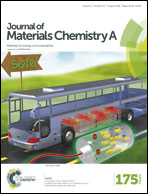Microporous polyimides with functional groups for the adsorption of carbon dioxide and organic vapors†
Abstract
Highly cross-linked microporous polyimide networks using (hexafluoroisopropylidene)diphenyl, benzophenone and biphenyl as linking struts and tetraphenylmethane and tetraphenyladamantane as net nodes were synthesized under well controlled polymerization conditions. The resultant polyimides show initial decomposition temperatures over 500 °C and BET surface areas up to 781 m2 g−1 with quite uniform pore sizes at around 0.5 nm. It is found that the presence of a high density of trifluoromethyls gives rise to a simultaneously larger CO2 uptake (13.5 wt%, 273 K/1 bar) and CO2/N2 selectivity (53.5, IAST method), while the introduction of benzophenone groups enhances the interaction between the CO2 molecules and polymer skeleton, thereby leading to a high heat of adsorption (33.3 kJ mol−1) and selectivities of CO2/N2 (59.2) and CO2/CH4 (15.8). The polyimides exhibit large adsorption capacities for organic vapors such as benzene (104.9 wt%) and cyclohexane (60.2 wt%) at 298 K and P/Po = 0.8. In addition, the low-surface-energy trifluoromethyls significantly decrease the water uptake in the fluorinated polyimide compared to the non-fluorinated samples. The improved hydrophobicity is advantageous for the practical application of porous adsorbents in CO2 capture from flue gas and natural gas.


 Please wait while we load your content...
Please wait while we load your content...